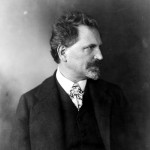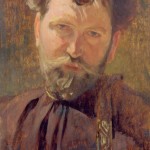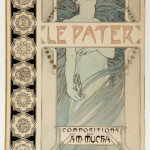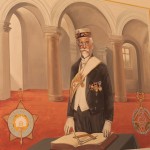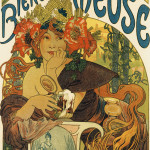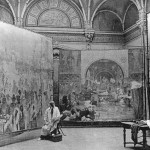Alfons Mucha, artist and mason… Mucha: the interesting coexistence of a profound and sincere catholic education with the choice of becoming a mason
When we talk about Art Nouveau, the name of the one who has characterized more than any others have this extraordinary style with his unmistakable technique and genial creations quickly comes to mind: Alfons Maria Mucha (1860-1939).
Famous all around the world, the Czech painter and decorator is the author of astonishing paintings, illustrations, postcards and drawings. Alfons Mucha is also a creator of jewelry and other marvels of applied art. All his creations are the outcome of a personal artistic journey that created a language to open new expansion horizons to art by originally rethinking elements of the past.
The most famous creations of Alfons Mucha have usually the feminine figure as a main element, in her double role of an angel-women and femme-fatale. Mucha’s woman, full of sensuality and eroticism is represented in extraordinary graphic compositions through wavy and dynamic lines that combine the human element with floral shapes. She is the archetype of the eternal feminine and becomes the example that synthesizes the aesthetic canons of the beauty concept of an entire era. It is impossible not to be fascinated nowadays by the brilliant bright posters such as those created for the “divine” Sarah Bernhardt. She was the artist’s immortal muse, the very symbol of Art Nouveau and Belle Époque, which made Mucha one of the best known and sought for artists of his time.
 In addition to the image of a brilliant painter, there is an aspect less famous but much more intimate of Alfons Mucha, a side less known of the man and artist. Like many great artists and writers of that era, Mucha was equally interested in esotericism that he considered an important part of his life and art. In Paris, he often attended spiritual sessions, followed the meetings and was in contact with members of the Theosophical Society and other occult circles of the capital. In Parisian coffee shops, he was discussing occult sciences and spirituality with the most important esotericists of the time. However, the event that greatly influenced his life and art was his adherence to the Freemasonry. Mucha approached the Masonry in 1897 and one year later, at age 38, on January 25th 1898, he was initiated in the Parisian Lodge “Les Inséparables du Progrès” belonging to the Grand Orient of France. Since then onwards the artist remained faithful to Masonic ideals until the day of his death. The knowledge he gained in the Lodge and the study of esoteric symbolism had an extraordinary influence on his artistic work. This is particularly noticeable in important works such as “Le Pater” and “The Slav Epic”. “Le Pater” is an illustrated volume published in Paris on December 20th 1899, approximately one year after his initiation in the Masonry. In this volume, Mucha combines the artistic and literary element with his religious and philosophical vision of existence. The result is an esoteric interpretation of the most important Christian prayer in which the initiatory symbolism conceived by the author in order to pass young generations a message of hope on the future of Humanity is highlighted. The coexistence of his profound and sincere catholic education with the choice of becoming a mason, are two things in which the painter never saw contradiction.
In addition to the image of a brilliant painter, there is an aspect less famous but much more intimate of Alfons Mucha, a side less known of the man and artist. Like many great artists and writers of that era, Mucha was equally interested in esotericism that he considered an important part of his life and art. In Paris, he often attended spiritual sessions, followed the meetings and was in contact with members of the Theosophical Society and other occult circles of the capital. In Parisian coffee shops, he was discussing occult sciences and spirituality with the most important esotericists of the time. However, the event that greatly influenced his life and art was his adherence to the Freemasonry. Mucha approached the Masonry in 1897 and one year later, at age 38, on January 25th 1898, he was initiated in the Parisian Lodge “Les Inséparables du Progrès” belonging to the Grand Orient of France. Since then onwards the artist remained faithful to Masonic ideals until the day of his death. The knowledge he gained in the Lodge and the study of esoteric symbolism had an extraordinary influence on his artistic work. This is particularly noticeable in important works such as “Le Pater” and “The Slav Epic”. “Le Pater” is an illustrated volume published in Paris on December 20th 1899, approximately one year after his initiation in the Masonry. In this volume, Mucha combines the artistic and literary element with his religious and philosophical vision of existence. The result is an esoteric interpretation of the most important Christian prayer in which the initiatory symbolism conceived by the author in order to pass young generations a message of hope on the future of Humanity is highlighted. The coexistence of his profound and sincere catholic education with the choice of becoming a mason, are two things in which the painter never saw contradiction.
He left France and after a stay in the United States, Mucha returned to Europe to settle in Prague. Here he started working immediately on the re-founding of the new Czechoslovakian state’s Masonry and its dissemination in the region. He actively took part in the founding of some masonic lodges in Bohemia among which, in 1919, the first Czech speaking lodge “Jan Amos Komenský”, still existing today and functioning as “Lodge Comenius” under the obedience of the Grand Lodge of the Czech Republic (VLČR).
For the Comenius Lodge, Mucha even created a lodge jewelry and he did the same for many other lodges in that period. He even played an active part in the lodge “Josef Dobrovský” of Plzeň, still active nowadays. In those years the painter had already reached the high degrees of Freemasonry (he was granted the grade 33° of the Ancient and Accepted Scottish Rite) and was elected Grand Master of the Grand Lodge of Czechoslovakia, becoming in fact the spiritual and moral guide of the Order. On June 8th 1922, he went to Lausanne to obtain the international recognition of the national Masonic institution, accompanied by a delegation of the Czechoslovakian Supreme Council of the Scottish Rite. In 1923, he was even named Sovereign Grand Commander of the Supreme Council of the Ancient and Accepted Scottish Rite of Czechoslovakia, thus reaching the highest degrees of the Organization. This prestigious title was even re-awarded to him in 1930. In his works, Mucha expresses his commitment to his adherence to Freemasonry. In Czechoslovakia, the organization was a promoter of the times of brotherhood ideals, freedom, and equality and actively engaged in the creation of the most important cultural and civil institutions of the new State. Mucha can be considered, and in fact, he really is, the father of modern Czechoslovakian Masonry, due to his great human and artistic commitment to it. Indeed, many of the artist’s works were inspired by its symbolism but just as well, he created a great number of works for the Masonry. Among these, there are various Lodge jewelry, chalices for the ritual agapes, aprons and other outfits for the officers of the Grand Lodge of Czechoslovakia. Nowadays, some of these accomplishments are hosted in various Czech museums. Likewise, there are many Masonic documents signed by Mucha and kept in the archives of VLCŘ; it is a valuable material for the reconstruction of both his biography and the events of the Freemasonry in the Czech lands.
Nevertheless, as shown before, there is another work where one can see the real influence played by the esoteric thinking on the artist. It is his greatest masterpiece, the fruit of the profound love that he was feeling for his country and for all Slavic people whom he wished free from the foreign domination. This is, by all means, “The Slav Epic”, a series of 20 historical-mythological paintings. The artist worked on these from 1910 to 1928. In this work of extraordinary beauty, human figures symbolize the forces that inspire the existence and each of its elements is charged with esoteric meanings. The work was completed in 1928 and in the same year, it was donated to the city of Prague to celebrate the tenth anniversary of the proclamation of the Republic.
Mucha created other esoteric paintings and one in particular, less known, depicting the Masonic apprentice carrying out his symbolic work on the rough stone, a symbol of his interiority. Nowadays, the Grand Lodge of the Czech Republic owns this painting along with other works of art created by the artist.
When the Germans invaded Czechoslovakia on March 15th 1939, Mucha still had the leading role of Czech Freemasonry. For this reason, along with the blame of being a patriot he was one of the first victims of the Gestapo. He was arrested and subjected to various interrogations. Because of old age and stress caused by tragic events, his health conditions worsened and a few months later Mucha died, on July 14th 1939. Today, his remains lie in the Monumental Cemetery of Vyšehrad in Prague. In 1999, the Grand Lodge of the Czech Republic in honor of its late and beloved Grand Master dedicated to the memory of the great artist a French language lodge, still active nowadays: “Alphonse Mucha” no.7 under the Orient of Prague.
by Mauro Ruggiero





